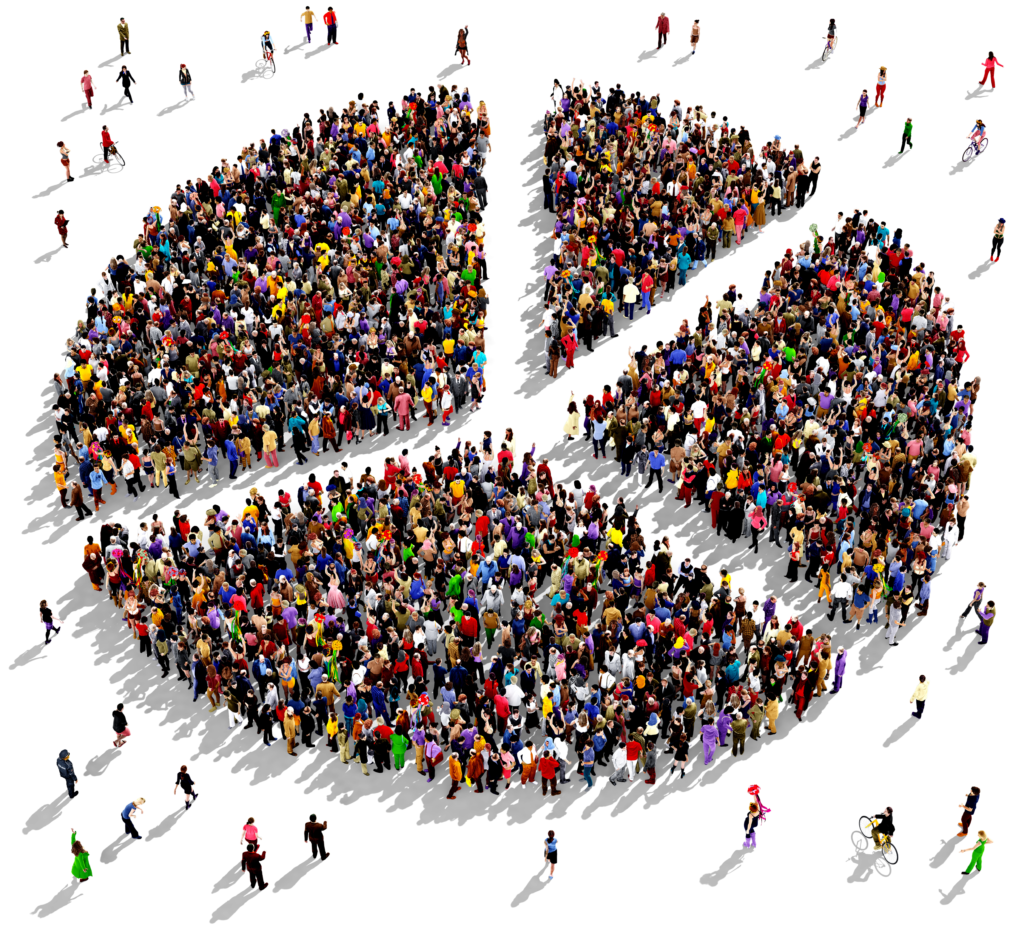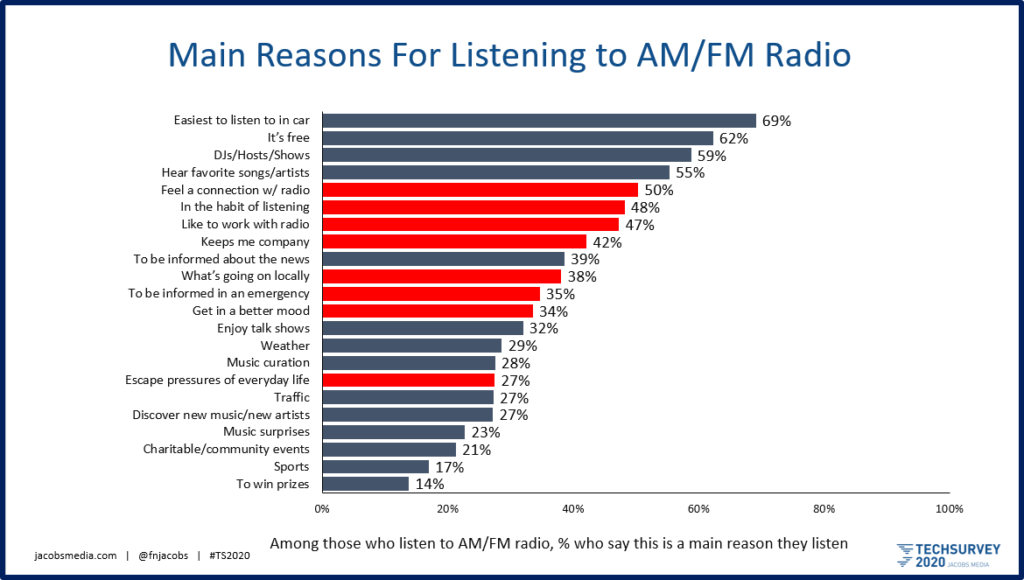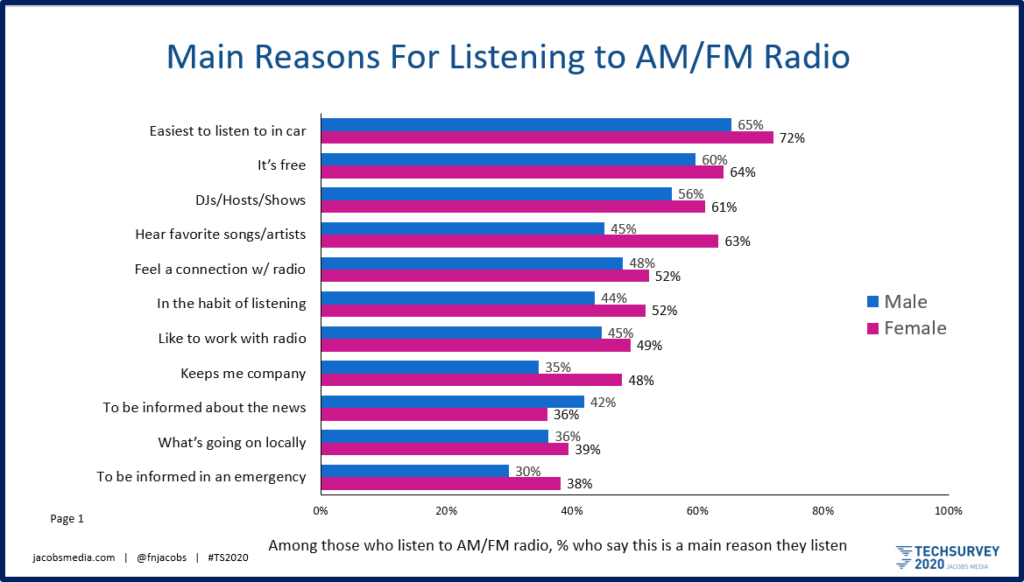
We may have lucked out with this year’s Techsurvey. It was fielded as usual in January/February. And as it turns out, that was just a couple precious weeks ahead of the coming of the coronavirus crisis here in North America. It’s almost hard to remember how we were feeling six weeks ago, but it was profoundly different than our view of the world today.
Every year since 2004-05, we have dutifully conducted this massive web-based research study among commercial radio listeners. Most of our 46,000+ respondents are among the medium’s best customers. They may not represent the overall population, but they are the “20” in the “80/20 Rule” – the people who do the lion’s share of radio listening.
Another unique aspect of Techsurvey is the format breakouts – 14 to be exact – representing a broad array of music and spoken word formats. (Remember, public radio and Christian music radio have their own surveys). These format profiles are essential to help inform programmers, sales managers, and digital directors understand their unique audience.
And for a medium facing challenges from satellite and streaming radio, as well as podcasts, a look at the core is critically important to the industry’s overall health and welfare.
All that was the case before coronavirus. Now that the world, the U.S., and the radio business are facing truly existential challenges, we need all the guidance we can get.

At the end of many of my presentations, I am often asked, “What does this mean to my station?” or “What am I supposed to do with this data?”
One thing I’ve learned during my 4+ decades in radio surveying is that research results are very much in the eye of the beholder. Whether it is focus groups or a mega study of tens of thousands of respondents like in Techsurvey, observers often come away with very different takeaways and “To Do Lists” after reviewing research.
After all these years, I like to think of myself as something of a “Data Whisperer” – looking at the charts, graphs, and percentages, and then focusing on how to apply the data to typical situations.
Or even like the one we’re facing now.
Techsurvey does a wonderful job with lots of the basics. When stations look at their discreet audience’s data, the easy stuff is understanding the apps they download, the sites they stream, the TV they watch, and the social media sites where they interact. That information alone serves as a great guide to learning more about what an audience is doing when they’re not listening to radio.
Where it gets more interpretive is when we look at some of the less obvious data. And that when some smart extrapolation can pay huge dividends.
So, let me tell you what I’m hearing in these data whispers.
Like any other researcher, I have my go-to reports and charts. And perhaps my favorite is called “Why Radio?” In a world where consumers have seemingly infinite choices for entertainment and information, why do they still listen to broadcast radio? What benefits do they derive from listening to AM and/or FM stations?
To quote the late marketer, Clayton Christensen, what is radio’s “job to do” now that our lives are being turned upside-down, with no real end in sight?
We gave each and every respondent a long list of radio’s potential attributes, and asked them to tell us which are the main drivers that explain their relationship to radio. Every year, some move up and down as you might suspect. But overall, the data are remarkably stable. And they provide important insights into what people need RIGHT NOW as they increasingly find their lives turning upside down.
In TS2020, we can’t see precisely how people are feeling right now because the coronavirus began its insidious invasion of our lives right after our fieldwork concluded. But based on our interactions with friends, family, clients, and people we’re still fleetingly seeing out in public, it’s not hard to imagine that fear, anxiety, and depression are in the forefront. So, when these feelings take over our psyches, what are the ways most people try to alleviate these powerful emotions?
A look at the chart below speaks volumes about what role broadcast radio plays in people lives – before a global pandemic.

As we’ve become accustomed to seeing in Techsurvey, radio’s ease of use in the car is a huge benefit – a main reason for nearly seven in ten respondents. But lets put that in perspective. As the coronavirus crisis plays out, there will be fewer and few people in cars, commuting to and from work, dropping off/picking up kids at school, running errands, and socializing.
In second place, the fact radio is free a standout attribute for more than six in ten respondents. As the economy slips into a recession, all those subscription services accumulating these past few years may very likely be scrutinized. Do we need Spotify, cable TV, Netflix, satellite radio, Disney+, and Hulu? So, a free service like radio has an inherent advantage. It’s simple to use, totally familiar, and it doesn’t cost a dime. As jobs security gets dodgy and budgets are stretched, this is a promotable, marketable value. In fact, it’s a steel sword.
Not surprisingly, personalities and music are close behind. They are radio’s content foundation, and they matter. In spite of the industry’s well-publicized staffing cutbacks – many of which were on-air staffers – there are still thousands of DJs, shows, and hosts that matter dearly to these core fans.
But it’s the red bars that are even more worthy of your attention, consideration, and creativity. They are what we call “emotional benefits” – in many ways, broadcast radio’s foundation. About half simply say they feel a connection to radio stations or are in the habit of listening. And for that, you can give a handclap to the many talented and dedicated people who came before you to build impressive brands that have stood not only the test of time, but also survived various ownership changes and other hardships and speed bumps over the years.
And next comes the truly interesting stuff – the things you never hear in on-air positioning statements or see on billboards. Companionship, emergency information, mood elevation – all designated by at least one-third of respondents nationally. They are broadcast radio’s “stealthy” benefits that matter to fans, but usually are ignored by management teams. The great programmers know these values are a big part of the fabric of why people listen, but they rarely, if ever, have a place in a station’s perceptual research or the ensuing strategic conversation.
And yet, isn’t that what this coronavirus madness is all about? At a time when all the familiar trappings and comforts of life are disappearing with each passing day – restaurants, movies, concerts, sports, bars – radio is still there, providing these foundational benefits.
And don’t think they won’t become even more important as this crisis worsens. It will be the little things – a DJ acknowledging a listener on Facebook, playing a request, offering soothing words, and connecting the music to people’s lives – that will be remembered and talked about. If people are huddled up in their homes, apartments, condos, and dorms, radio’s intimate connection can become even more powerful.
And here’s a bonus finding. For everyone of these radio listening drivers I just mentioned, women value each of them even more than men.

Consumers are passionate about their radio stations, in spite of the many changes that have roiled the industry. And as we discussed since the coronavirus become the topic of the year, it’s that emotional connection that gives radio the chance to remind audiences why they fell in love with radio to begin with. Compassion, connection, mood elevation, local information, updates on what’s happening in their communities – they are all the ingredients that got radio to the dance in the first place.
I know for some stations and their harried staffs, this kind of service – especially given we all have our personal situations to grapple with – isn’t easy under the best of times. And with depleted financial and human resources, there’s only so much you can do.
But my prediction is this – the stations that distinguish themselves during these unprecedented times will enjoy brand growth, advertiser success, and untold benefits for years to come. Techsurvey 2020 provides the road map. Now you have to follow it.
And here’s what I’ll promise you. If you’re one of the 500+ stakeholder stations, you will have the chance to see your actual audience’s data – just in time to deal, plan, and strategize for this crisis this coming Monday.
But if your station didn’t participate in this year’s Techsurvey, I’ll make you a deal. Join us for our free webinar on 3/26. And whether you can attend or not, I will send your format information for this “Why Radio?” chart. It should help you navigate some of the uncertain waters ahead. The 14 format categories are on the word cloud below. My email is [email protected]

There’s no playbook for this one. Bill Drake, Rick Sklar, Steve Rivers, or Oedipus never went through anything like this.
It’s a test to see what we’re capable of under the scariest and most dangerous time anybody who’s ever worked in radio has ever faced.
The data provides the “radar” to help you figure this thing out.
Use it.
Send me an email at [email protected] and let me know your format of choice. I’ll send you a chart.
We have resources for your station and your company, updated multiple time a day here.
And to see a more extensive look at the results of Techsurvey 2020, the biggest radio study in the world, register here. It’s in partnership with our friends at AllAccess. Register here.
- In Radio, You Just Never Know - April 17, 2025
- The Secret To Making A Great Podcast (And Great Radio) - April 16, 2025
- I Read The (Local) News Today, Oh Boy! - April 15, 2025




Leave a Reply